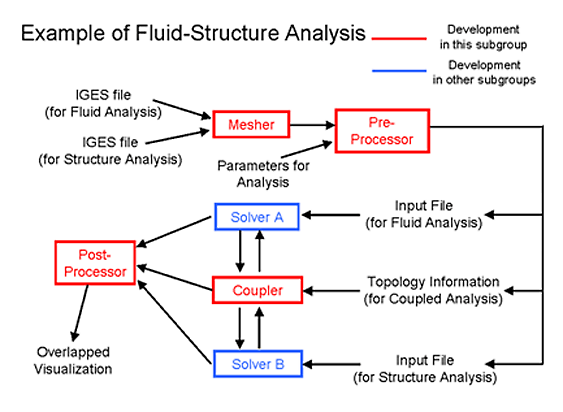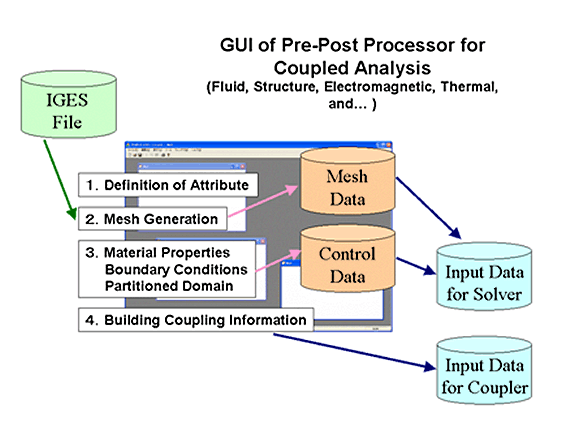Professor Shinobu YOSHIMURA
School of Engineering
The University of Tokyo

"Coupled analysis" in this subproject means a multi physics analysis. The coupled analysis contains mutual related compound phenomena with more than two kinds of mechanical and electromagnetic phenomena.
The subject of this subgroup is to develop an innovative general-purpose coupled analysis system which integrates various kinds of solvers for fluid, structure, thermal conductive and electromagnetic analysis. With cooperation of heavy industries, electric, and steel companies on behalf of Japanese industrial circles, some target coupled problems are set up to prove practical applicability of the developed system. In a period for this project, the target problems will be solved with the innovative general-purpose coupled analysis system.
The R&D issues of this subproject are listed below :
(1) Development of Coupled Analysis Engine with Coupler
A partitioned approach is employed in the innovative general-purpose coupled analysis system. It holds the key to the solution that each coupled physical value for fluid, structure, thermal conductive and electromagnetic analysis should be mutually exchanged through a coupled analysis system called "coupler".
The coupler to exchange coupled physical values can be applied when solvers referenced through the coupler are different in mesh topologies. Different time steps for coupled solvers can be employed for coupled analysis with the coupler. In addition, the coupled analysis engine with coupler can run on parallel computers.
(2) Development of Adapted Mesh Generator and General-purpose Pre-Post Processor for Coupled Analysis
An automated mesh generator is developed, which can be applied for complicated geometrical shapes of real engineering parts. A hybrid mesh generation technique for boundary layer of fluid analysis and a mapping function for physical values between different physics are also developed.
In addition, a building process for an interface model of coupled analysis is focused on as an independent modeling process which is different from modeling processes for each solver. Tools to define boundary conditions and parameters for the interface model are also developed. To visualize results of a coupled analysis, we develop the post processor which can visualize overlapping results from coupled solvers.
(3) Development of Electromagnetic Analysis System
The algorithm for high-speed and less-memory which was developed for NEXST_Magnetic is improved and adapted to ADVENTURE_Magnetic which was developed in the ADVENTURE Project. The new electromagnetic analysis code will have functions of non-linear magnetostatic analysis and transient eddy current analysis. In addition the new code can run on parallel computers efficiently.

Fig. 1 Schematic View of Whole Coupled Analysis System

Fig. 2 Schematic View of Pre-Post Processor for Coupled Analysis



